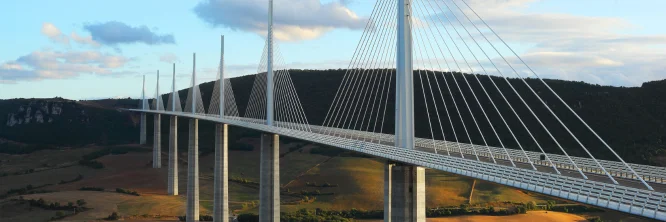Índice
Bridges and viaducts are essential structures that have shaped human civilization, connecting people and places across bodies of water, valleys, and other geographical barriers. While often used interchangeably, bridges and viaducts have distinct characteristics and purposes. This article will delve into the definitions, differences, and historical significance of these structures, exploring iconic examples such as the Millau Viaduct.

A bridge is a structure built to span physical obstacles, such as rivers, roads, or railways. Its primary function is to provide a passageway for pedestrians, vehicles, or utilities without interrupting the flow of traffic or water underneath. Bridges can vary greatly in size, design, and materials, from small footbridges to massive suspension bridges.
A viaduct is a structure that carries a road or railway at a considerable height above ground level. Unlike bridges, viaducts are often part of a larger transportation system and are used to overcome changes in elevation or to cross valleys, ravines, or other obstacles. Viaducts are typically constructed as a series of arches or supported by piers.
While bridges and viaducts serve similar purposes, there are key distinctions between the two:
Purpose: Bridges are primarily designed to span bodies of water, while viaducts are often used to overcome changes in elevation or to cross land.
Structure: Bridges can have a variety of structures, including beam, truss, arch, suspension, and cable-stayed designs. Viaducts are more commonly constructed as a series of arches or supported by piers.
Length: Viaducts tend to be longer than bridges, as they are often part of extended transportation routes.
The Millau Viaduct in France is often considered one of the most impressive viaducts in the world. Its towering pylons and cable-stayed design make it an engineering marvel. Other notable viaducts include the Viaduc de Garabit in France, known for its graceful arch, and the Centennial Bridge in Canada, a cable-stayed structure spanning the Saint Lawrence River.
Bridges can be classified based on their structural design:
Beam bridges: The simplest type, consisting of a horizontal beam supported at both ends.
Truss bridges: Composed of triangular units that provide greater strength and stiffness.
Arch bridges: Utilize the compressive strength of arches to span openings.
Suspension bridges: Supported by two towers and cables, with the roadway suspended from the cables.
Cable-stayed bridges: Similar to suspension bridges, but with cables that connect directly to the towers.
Bridges and viaducts have played a pivotal role in the development of transportation networks. They have facilitated trade, commerce, and cultural exchange by connecting distant regions. From ancient Roman aqueducts to modern suspension bridges, these structures have pushed the boundaries of engineering and design.
Bridges and viaducts have played a crucial role in human history, facilitating trade, commerce, and cultural exchange. From the ancient Roman aqueducts to the modern-day suspension bridges, these structures have shaped civilizations and connected people across vast distances.
Ancient civilizations: The Romans were particularly skilled in bridge construction, building numerous aqueducts, viaducts, and other bridges throughout their empire. These structures helped to provide essential resources and infrastructure to their cities and towns.
Industrial revolution: The Industrial Revolution led to a surge in bridge construction, as new technologies and materials enabled the building of larger and more complex structures. Bridges played a vital role in connecting industrial centers and transporting goods and raw materials.
Building bridges and viaducts can be challenging due to factors such as geographical constraints, environmental concerns, and the need to withstand natural forces. Engineers and designers have faced numerous challenges in overcoming these obstacles and developing innovative solutions.
Materials and technology: Advances in materials science and construction technology have enabled the development of stronger, more durable, and more aesthetically pleasing bridges. Materials such as steel, concrete, and composite materials have been used to create structures that can withstand extreme weather conditions and heavy loads.
Environmental impact: The construction of bridges and viaducts can have a significant impact on the environment, including habitat destruction and water pollution. Engineers must carefully consider the environmental implications of their designs and take steps to minimize negative impacts.
As the world continues to grow and develop, the demand for bridges and viaducts will likely increase. Engineers and designers are constantly exploring new technologies and materials to create innovative and sustainable structures.
Sustainable design: Future bridges and viaducts are expected to incorporate sustainable design principles, such as the use of renewable materials, energy-efficient lighting, and environmentally friendly construction methods.
Smart infrastructure: Advances in technology are also leading to the development of "smart" bridges and viaducts that can monitor their own health, communicate with other infrastructure systems, and adapt to changing conditions.
By understanding the historical significance, challenges, and future trends in bridge and viaduct construction, we can appreciate the incredible achievements of engineers and designers and the vital role that these structures play in our society.
Bridges and viaducts are essential infrastructure that have shaped the world we live in. While they share similarities, their distinct characteristics and purposes make them unique. By understanding the differences between bridges and viaducts, we can appreciate the engineering feats that have gone into their construction and the important role they play in our society.
Bridges and viaducts are more than just engineering marvels; they are symbols of human ingenuity and progress. As technology continues to advance, we can expect to see even more innovative and sustainable designs for these structures.
Preserving historic bridges: Many historic bridges are valuable cultural and engineering landmarks. Efforts should be made to preserve and maintain these structures for future generations.
Investing in sustainable materials: As we face increasing environmental challenges, it is important to invest in sustainable materials and construction methods for new bridges and viaducts.
Promoting public awareness: Educating the public about the importance of bridges and viaducts can help foster appreciation for these structures and encourage support for their preservation.

¡Muchas gracias!
Hemos recibido correctamente tus datos. En breve nos pondremos en contacto contigo.